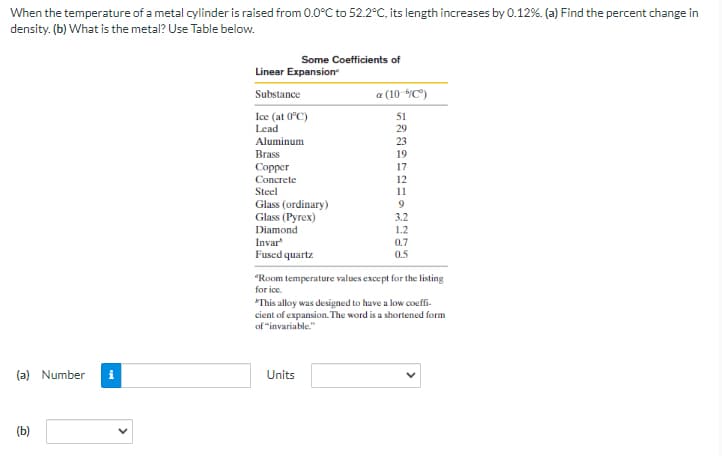When the temperature of a metal cylinder is raised from 0.0°C to 52.2°C, its length increases by 0.12%. (a) Find the percent change in density. (b) What is the metal? Use Table below. Some Coefficients of Linear Expansion Substance a (10 C) lce (at 0C) Lead 51 29 Aluminum 23 Brass 19 Copper 17 12 Concrete Steel Glass (ordinary) Glass (Pyrex) 11 3.2 Diamond Invar 1.2 0.7 0.5 Fused quartz "Room temperature values except for the listing for ice. *This alloy was designed to have a low coeffi- cient of expansion. The word is a shortened form of "invariable." (a) Number Units (b)
When the temperature of a metal cylinder is raised from 0.0°C to 52.2°C, its length increases by 0.12%. (a) Find the percent change in density. (b) What is the metal? Use Table below. Some Coefficients of Linear Expansion Substance a (10 C) lce (at 0C) Lead 51 29 Aluminum 23 Brass 19 Copper 17 12 Concrete Steel Glass (ordinary) Glass (Pyrex) 11 3.2 Diamond Invar 1.2 0.7 0.5 Fused quartz "Room temperature values except for the listing for ice. *This alloy was designed to have a low coeffi- cient of expansion. The word is a shortened form of "invariable." (a) Number Units (b)
Chapter2: The Kinetic Theory Of Gases
Section: Chapter Questions
Problem 13CQ: One might think that the internal energy of diatomic gases is given by Eint=5RT/2 . Do diatomic...
Related questions
Question

Transcribed Image Text:When the temperature of a metal cylinder is raised from 0.0°C to 52.2°C, its length increases by 0.12%. (a) Find the percent change in
density. (b) What is the metal? Use Table below.
Some Coefficients of
Linear Expansion
Substance
a (10 YC")
Icec (at 0°C)
51
Lead
29
Aluminum
23
Brass
19
Сopper
17
12
Concrete
Steel
11
Glass (ordinary)
Glass (Pyrex)
Diamond
Invar
3.2
1.2
0.7
0.5
Fused quartz
"Room temperature values except for the listing
for ice.
"This alloy was designed to have a low coeffi-
cient of expansion. The word is a shortened form
of "invariable."
(a) Number
Units
(b)
>
Expert Solution
This question has been solved!
Explore an expertly crafted, step-by-step solution for a thorough understanding of key concepts.
Step by step
Solved in 2 steps with 2 images

Knowledge Booster
Learn more about
Need a deep-dive on the concept behind this application? Look no further. Learn more about this topic, physics and related others by exploring similar questions and additional content below.Recommended textbooks for you


College Physics
Physics
ISBN:
9781938168000
Author:
Paul Peter Urone, Roger Hinrichs
Publisher:
OpenStax College

Physics for Scientists and Engineers, Technology …
Physics
ISBN:
9781305116399
Author:
Raymond A. Serway, John W. Jewett
Publisher:
Cengage Learning


College Physics
Physics
ISBN:
9781938168000
Author:
Paul Peter Urone, Roger Hinrichs
Publisher:
OpenStax College

Physics for Scientists and Engineers, Technology …
Physics
ISBN:
9781305116399
Author:
Raymond A. Serway, John W. Jewett
Publisher:
Cengage Learning

Principles of Physics: A Calculus-Based Text
Physics
ISBN:
9781133104261
Author:
Raymond A. Serway, John W. Jewett
Publisher:
Cengage Learning

University Physics Volume 1
Physics
ISBN:
9781938168277
Author:
William Moebs, Samuel J. Ling, Jeff Sanny
Publisher:
OpenStax - Rice University